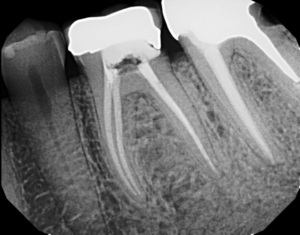Associate’s Corner: A Tricky Dance
 By Helen X. Yang, D.M.D.
By Helen X. Yang, D.M.D.
What do you say when a patient returns for recall with a brand-new, defective restoration?
In this issue, I’d like to share a situation that is fairly routine, yet rife with possible complications, as well as three experienced endodontists’ perspectives on how they would approach it.
I saw Mrs. S to evaluate tooth #19 in June 2018. The tooth had deep distal caries extending pulpally and subgingivally, and was diagnosed with symptomatic irreversible pulpitis/ symptomatic apical periodontitis. She was initially unaware that crown lengthening may be needed, became upset to hear about the potential additional cost, but decided to save the tooth. Root canal therapy was completed uneventfully at the next appointment, and the tooth was temporized with a sponge pellet and glass ionomer as was my routine. A post-treatment report with radiographs was provided to the patient to give to her general dentist.
Six months later, Mrs. S returned for recall and reported the tooth to be asymptomatic. A periapical radiograph showed tooth #19 now has a crown with short distal margin placed on top of my sponge pellet/glass ionomer temporary.

Per ADA principles of ethics, doctors have an obligation to communicate with patients truthfully without deception. This situation calls for diplomatic communication that balances presenting facts while avoiding bad mouthing the other clinician. The responses of three Chicago endodontists are summarized below:
— “What if you point out the deficiency to the patient, and they start asking a bunch of questions?: Why did this happen? Did they mess up my tooth? Should I demand a refund? You could be opening a can of worms. The last thing you want is your referral hearing from an agitated patient out of the blue blaming them. I would try to reach the referring dentist while the patient is still in the chair to alert them of the situation and ask how they prefer us to approach it. Typically, I tell the patient, ‘The root canal treatment is holding up well, and there doesn’t seem to be any evidence of periapical disease. I will provide a report to your doctor so they know to continue to follow up with you.’ Then, I emphasize the importance of returning for another recall. If this is a frequent occurrence, I tend to get more firm with the referring dentist.”
— “This unfortunately happens more often than you might think. My reaction depends on who the patient is, who the restorative dentist was, and how egregious is the clinical error. Some dentists will respect your opinion, and others think, ‘Who are you to tell me how to do a crown?’ I explain to the patient what I see without judgment: ‘See where the crown meets the filling and there’s a small gap? Usually the crown meets the tooth in a tight junction. I’d like you go to back to Dr. So-and-so and have him check it out.’ I forward the x-ray to the referring doctor, and sometimes I will even print a copy for the patient. If the patient asks how serious this is, I am honest: ‘I think long term this is not a sustainable situation. It’s okay now, but bacteria might sneak in through the gap and reinfect all of our hard work.’ Make sure you make a note of this conversation in your clinical records. Now the patient is informed; you’ve done your job.”
— “You have an obligation to the patient first. While they are in my chair, I might say, ‘I see something about the way this crown fits that I’m not sure about. I’ll shoot your dentist a note about it. When is your next cleaning/checkup?’ In my experience, few general dentists remake their new crown right away; that would be admitting defeat. By encouraging patients to follow up on their next cleaning appointment, you don’t raise alarms, and the x-ray speaks for itself. If the patient asks whether their dentist made a mistake, I say, ‘No, this looked like a very difficult crown to do perfectly, but I think there is something here that can be improved upon.’ You can also add, ‘Sometimes these things show up only with a specific angle x-ray so I’m glad we caught it early.’ With the general dentist you also want to be diplomatic; point out the issue, emphasize that a retained sponge pellet and open margin leads to long-term endodontic failure, and let them make the next move.”
Skillful endodontists understand that while patients are our immediate customers, referring doctors are our long-term customers. The relationship can be even more delicate for young associates because we also need to manage the existing relationship between the referring dentist and the owner endodontist. It is wise to get comfortable reaching out to referring dentists in a friendly, non-judgmental manner, and practice these diplomatic conversations to familiarize yourself with the verbiage.
Dr. Helen Yang is chair of the AAE’s Resident and New Practitioner Committee.




